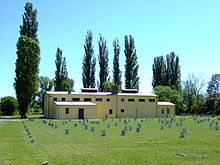Terezín is a town in the Czech Republic with around 3,000 inhabitants. It is mainly known for its fortress, and for the Theresienstadt concentration camp; see Holocaust remembrance.
Understand
This camp is located in the Sudetenland, annexed by Germany in 1938. It could be described a "showcase" concentration camp, built to make the internment look better than it actually was. The camp was mainly a temporary holding place for Jews before deportation to the gas chambers at Auschwitz.
Get in
By car
Take the D8 highway, get off at exit 35 or 45. There are multiple parking spots, biggest ones (but there is no shortage of parking space usually) are 1 east and 2 south of the city.
By bus
You can go from Prague, from the Nádraží Holešovice bus station. It takes about 1 hour and takes you to the 3 bus station at the "Terezin -- U památníku" bus stop. To avoid full bus, you can buy the tickets beforehand at the main bus office on Florenc B C metro station or online.
By train
It takes 1.5h to Bohušovice nad Ohří 4 train station, which is 4 km away (approx. 45 minutes by foot).
You can also come from Litoměřice - it's approx. 4 km away too.
Get around
The city is small enough to visit it by foot. But bring at least some refreshments - as there will be plenty of walking if you visit at least the areas listed here.
See



The main "attraction" here is the concentration camp area, which consists of several places:
- 1 Ghetto museum (Muzeum Ghetta). Placed in the building of a former school, it contains an extensive exhibition about the purpose and life in the ghetto - including cinematic artefacts. Expect at least 2-3 hours, if you will study the details. You will learn here about the life and death in the camp, the destinies of people coming in and out, and also about propaganda movies which were shot here to show the camps as a "good and safe place for living" for the imprisoned people.
- 2 Small fortress. A military citadel, which was used as a political prison during WW2 and as an internment camp for Germans after the war. The exhibition here is mainly devoted to the political prison aspect.
- 3 National cemetery (Just outside Small fortress). A cemetery mostly with victims from the fortress, approx. 10 000 in total. Of them 2 386 are named, rest are in mass graves. Both Christian cross and Jewish star are here. Many more 10s of thousands people who died here don't have any grave, because they were cremated and the ash dumped into the Ohře river.
- 4 Jewish cemetery and crematory. A relatively big remembrance area, with information about the crematory operation - including interior access, which is quite an unsettling experience. Approx. 9 000 people are buried here (mostly Jewish).
The whole city, being a former fortress from year 1780, is surrounded by a star-shaped wall.
Do
- 1 Golf Kotlina. A modern golf course with a restaurant (both closed in winter).
Buy
Eat
Multiple restaurants (local cuisine and pizza) and cafés are located 1 nearby the museum, around the "Smetanovy sady" park. The food is not nearly top-notch, but acceptable for the price.
Drink
Sleep
Connect
Go next
Lidice is a city completely destroyed by the Nazis, as a retaliation for assassination of Heydrich, with a remembrance area in place now - if you still feel like it after Terezin (very unlikely).


